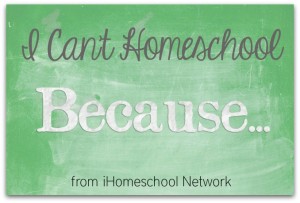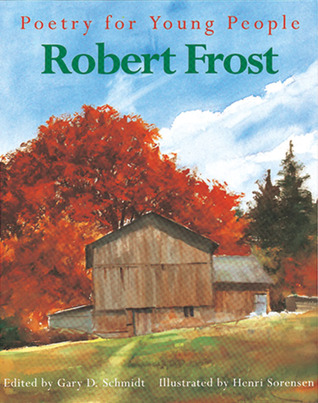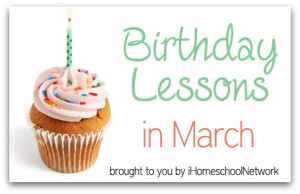 Hi, I'm Heidi and I homeschool my two sweet kids. I want them to know that learning is an exciting lifelong adventure! We love great books, unit studies, notebooking, lapbooking, and hands-on learning.
Hi, I'm Heidi and I homeschool my two sweet kids. I want them to know that learning is an exciting lifelong adventure! We love great books, unit studies, notebooking, lapbooking, and hands-on learning.Explore U.S. Geography with Snapshots Across America
Who doesn’t love learning through games? The Snapshots Across America board game is our favorite way of sharpening our U.S. geography skills. You can read my full review of Snapshots Across America at Curriculum Choice.
Iditarod Unit Study

A quick mention on the news late last week piqued our interest about the Iditarod, the famous dog sled race that crosses more than 1000 miles of Alaska in honor of a historic and heroic race for serum to save a town. I compiled a unit study and we worked on it a bit every day this week. I didn’t set aside our regular work, but with something they were so interested in I could use it as a fun way to finish off our days when all the other work was done.
Resources for our Iditarod Unit Study
Books
- Racing the Iditarod Trail by Ruth Crisman was our nonfiction resource book.
- The Bravest Dog Ever, The True Story of Balto by Natalie Standiford
- Togo by Robert J. Blake is a must read along with the Balto book, it gives the account of another dog hero of the famous 1925 serum race–Togo actually traveled 5 times more miles than Balto.
- Akiak, A Tale From The Iditarod by Robert J. Blake is a story of a modern Iditarod race dog.
Videos
- Discovery Channel’s Iditarod: Toughest Race On Earth: This Discovery channel 6-episode show gave us a front-row seat for the race, up close and personal with mushers and their dogs, both on the trail and at checkpoints. (We were able to watch on Netflix.)
Online Resources
- Homeschool Share: I used a few minibooks about Balto from a unit for Five True Dog Stories. For others topics I used blank minibooks from Homeschool Share’s lapbook resources page. I used Google image searches to print photos of Balto and Togo with their mushers.
- Iditarod Official Website: There is a lot of great information here for the current year’s race–musher profiles, race times and winners, and even news stories (like the death of one of the dogs this year). Note: This site raises money through paid “Insider” subscriptions so some content is not free. There are a few videos for classroom use that are free and a free downloadable map of the race trail.
- About.com has free coloring pages, word searches and crossword puzzles.
- Scholastic has a great Iditarod page with pictures and information–much of it from real Iditarod mushers!
A Peak Inside Our Iditarod Lapbooks
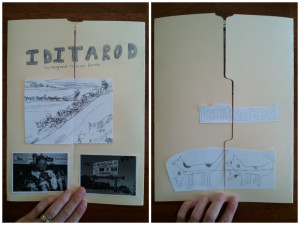
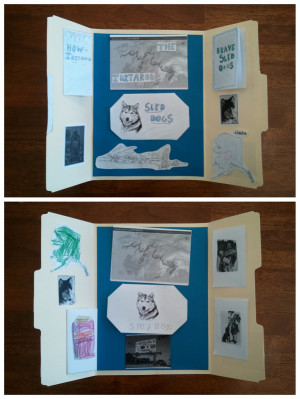
The information in the minibooks:
- The history of the Iditarod, both the 1925 serum run to save the residents of Nome from a diptheria outbreak, and the two sled dog heroes, Togo and Balto.
- The modern Iditarod Race
- All about sled dogs–their training and how they are cared for on the trail.
We enjoyed learning about the Iditarod and look forward to following the race in future years to cheer for our favorite mushers!
Thank you to the wonderful hostesses with fun link-ups on Fridays. Be sure to join the fun and see what other homeschoolers are up to!
Hands-On Math: Practice with Tally Marks
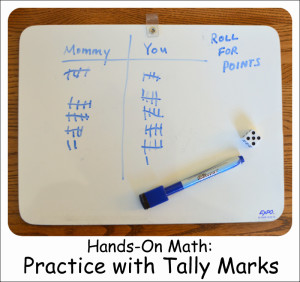
Simple supplies are all you need to practice with tally marks. We used a whiteboard (though pencil and paper would work) and a single die for a quick and easy game that provided lots of practice making tally marks, adding to existing marks, and counting up tallies. (Bonus math: practice counting by fives!)
I avoid a workbook style math curriculum for my son, after realizing in Kindergarten that it did not suit his learning style. We use the Life of Fred Elementary Series and an old series of books called I Love Math.
Life of Fred works well because the books focus on understanding math concepts, are based on funny stories, and each chapter only has a handful of questions. The I Love Math series (only available used) also contains stories, along with games, word problems, and suggestions for hands-on activities.
As needed I find extra hands-on practice for math concepts: like playing store for coin recognition and dividing items for even and odd.
We read about tally marks in I Love Math: How Do Octupi Eat Pizza Pie and I realized a little practice was in order. The book suggested counting straws, but I figured a little competitive game would be more fun.
I grabbed a die and small white board. I told him the simple rules: we take turns rolling the die, whoever gets to 25 points first wins! I kept tallies for the first game. On the second game it was his turn to keep track of our scores. (He decided the game needed a name, so we worked together to pick “Roll for Points.”)
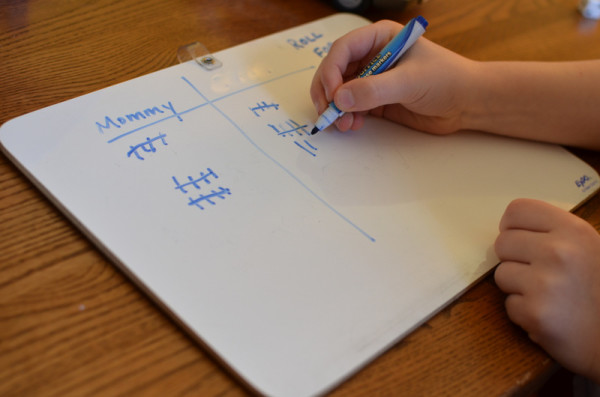
This game is quick and easy, so we’ll play it once in a while until he’s a pro with tally marks. Maybe later we’ll add extra dice, make the point goal higher, or even add the numbers on the dice together!
What are your favorite math games, whether it’s one you bought or made up yourself?
Schoolwork, Sickness and Sewing
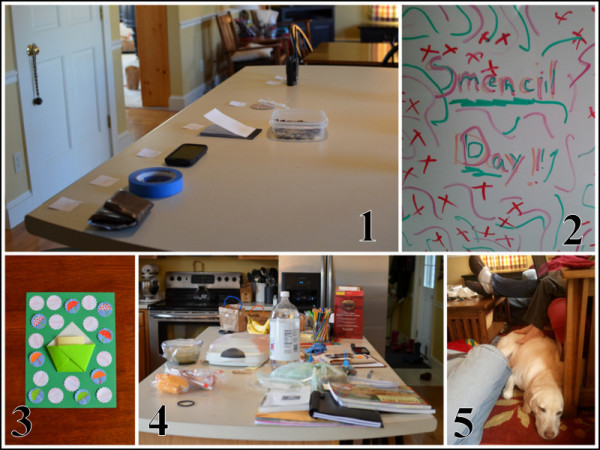
In our homeschool this week:
- I changed up the store game I frequently play with my son. I told him HE would be the storekeeper, and had to label items with prices. The catch: I would be trying to cheat him, so he had to really know his coin values! He loved this new twist.
- The kids declared Tuesday to be Smencil Day, announced on our whiteboard. It cracked me up–I’m known to love a good theme and will randomly declare it something-or-other day if we’re doing a few things that go together. I had told my cautious daughter that she should go ahead and use the Smencils (scented colored pencils) she received for Christmas instead of saving them forever, and little brother was happy to join her in making it an event. I allowed all schoolwork to be done in Smencils. Embrace the small joys!
- My daughter published another Writeshop project. This lesson was on Haikus and my daughter wrote one about spring. (My full review of Writeshop is in the works.)
- Does any one else have a counter that looks like this in the middle of a school day? Please say yes.
- Martha Dog is a sweet, sweet dog. She’s happy to stand in as a footrest during my son’s reading lesson. These moments make up for those others, like when she attempted to chew into her food bin this week to get at the 40 pounds of dog food.
I was happy with what we accomplished considering I was dragging with a nasty cold. It settled into my chest and disrupted my sleep all week. Thank goodness for audio books (Wind in the Willows free from Librivox) as I sipped hot tea! My daughter helped fix snacks and said “bless you” when I coughed (which was a lot!), my son cuddled (a rare event) and rubbed my back. It warmed my heart to see them as sweet caretakers.
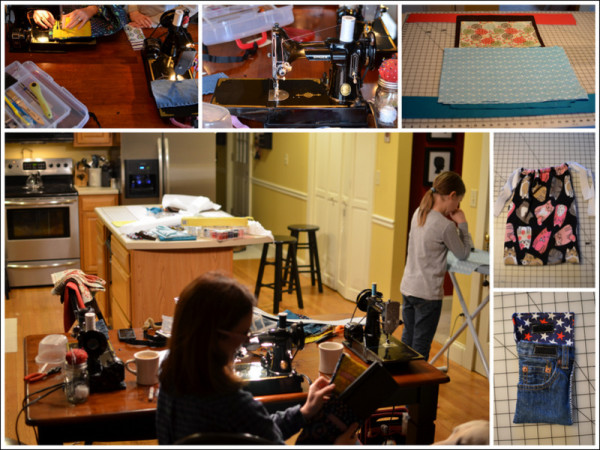
Thursday Auntie came for a sewing day. We usually do these on a Saturday (with a name, of course: Super Sewing Saturday), but she had a rare afternoon off from work so we took advantage. I was struck by so many things to be thankful for:
- Flexibility: How often do I say this? A lot! When the option to sew with Auntie came up, I could adjust our schedule. We got our core work done and will finish the rest today–an adjustment my daughter was happy to make.
- Sewing: It teaches valuable skills to my daughter, gives her a sense of pride, and is an activity we can share even in the years to come. Handicrafts of all sorts can fit the bill, sewing just happens to be our favorite.
- A sewing mentor: Sometimes when Auntie comes to sew with us she doesn’t get as much done on her projects because she’s helping us. She teaches us a lot, always has cool new tools for us to try, and also makes it a whole lot more lively and fun.
- Our sewing machines: We’re blessed to each have a Singer Featherweight–a sewing machine made over fifty years ago. Picked up at auctions, we treasure these little beauties that hum along and are a thing of beauty. (At least to sewing dorks like us. We call ourselves the Featherweight Fan Club.)
- My husband: My husband returned home at 7:00 AM from his 24-hour fire department shift. He made us a delicious chili for lunch and ran out to get pizza for dinner. And he didn’t say a word when we had to eat at the coffee table because every other surface was covered in sewing supplies. He’s a keeper.
My daughter sewed another project from her Kids Can Do It: Simply Sewing book (a fleece bag to bring to sleepovers), I made a case for my son’s iPod out of an old pair of his jeans, and we started work on a tote bag. A productive day!
Today we’re embarking on a last-minute interest-led study of the Iditarod after seeing it on the news this week. I’ll share the details and pictures when we’re done!
Other things from this week:
- I shared about a sanity-saving daily habit of Quiet Time. (Extra helpful when Mommy is sick.)
- I joined with other bloggers of iHomeschool Network to share some of the reasons why people think they can’t homeschool–and how we make it work! One of my fears before we took the plunge was that I can’t homeschool because then I wouldn’t have time for anything else!
Thank you to the wonderful hostesses with fun link-ups on Fridays. Be sure to join the fun and see what other homeschoolers are up to!
I Can’t Homeschool Because Then I Wouldn’t Have Time for Anything Else!
The bloggers of iHomeschool Network are getting together to write about some of the common reasons people give for why they couldn’t homeschool…maybe even reasons we had ourselves before we took the leap.
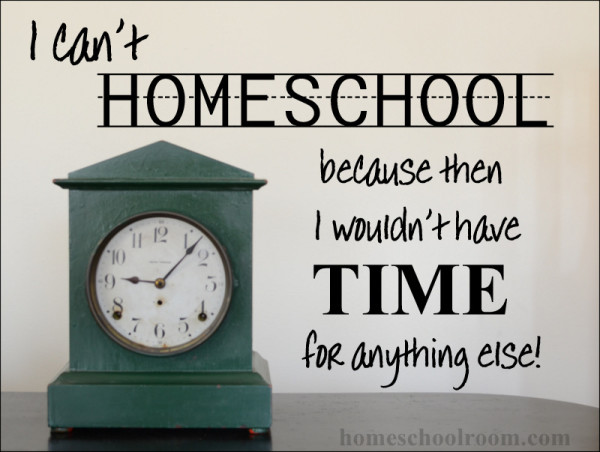
The biggest argument against homeschooling for me (you know, back when I thought only crazy people homeschooled) was “I’d teach all day then plan all night to be ready to teach the next day!” What I meant was: I can’t homeschool because then I wouldn’t have time for anything else!
Here’s what I’ve learned about accomplishing the homeschooling and household duties while still making time for me.
Accomplishing the Homeschooling
My first reality check: I don’t need to be teaching all day. I looked hard at the public school day, a schedule I was familiar with from years of volunteering. I started with their six hour school day and removed the time that the kids were waiting for the next activity or for their classmates to be ready, moving from place to place, having lunch or recess, or in independent reading time.
This is where I’d also like to put in a plug for the efficiency of homeschooling. My daughter picked up math concepts easily, but would still need to listen to more lecture and practice examples for the students who didn’t yet grasp the concept. At home, we can move right on. But I digress.
Working diligently after a prompt start in the morning we can be done our core work (and even some of the extras that don’t happen in public school) before lunch.
As far as planning all night, there are many time saving resources for homeschool teachers.
- There are open-and-go curriculum options. With some everything arrives in one box–you open the teacher’s guide and use it as directed. I won’t give specific recommendations here, because I’m not an expert in any of them. I lean towards curriculum with a bit more teacher involvement, tend to do a fair amount of tweaking, and even put together my own unit studies. Even so, an afternoon once a week is sufficient.
- Some options for home instruction are meant for the child to work through on their own. There are even computer-based programs that do the instructing. We use Teaching Textbooks for math, and this computer-based math curriculum does the lecturing and grading for me.
- Not all instruction must happen separately–a point that is especially important for large families. Other than reading, language arts, and math the rest of our subjects are done together. Many homeschool curricula give options for younger and older children.
Now that I’ve discussed the fact that it really isn’t teaching all day and having to plan all night, I’ll cover some of the other things to do that worried me before taking on this gargantuan task of educating my children.
Accomplishing Household Duties While Homeschooling
With the hours spent homeschooling, how does one accomplish housework, meal preparation, and running errands? This may be the greatest part of homeschooling. Really, I’m not kidding! Don’t think of it as “How will I get all this work done while trying to teach and plan for homeschooling?” Think of it as bringing on extra employees in the household business.
Homeschooling provides wonderful opportunities for life skills training. Public school children rush off to school in the morning, then return to find the house clean, the fridge stocked, and their clean clothes in their drawers. They often aren’t given many chores because they spend their after school time in extracurricular activities or doing homework. Instead of the household fairy doing all the work while they are gone, my children see and help with all the tasks.
- Cleaning: We have short morning chores to tidy the house, longer afternoon chores to clean something, and bigger jobs on the weekend. I put on music and call for a ten-minute tidy when necessary, instead of doing a whole-house pickup after they leave for school or go to bed.
- Cooking: Meal preparation provides practice for many skills. We start with helping to measure and stir, move to preparing easy recipes alone, and add working with heat and sharp tools. It helps the family, is a learning experience, establishes a necessary life skill, and gives them pride as others benefit from their work.
- Errands: Shopping together provides many opportunities to talk about wants and needs and financial management.
Not only does participating in these tasks help get the work of the household done, we are preparing our children for leaving our house and running their own household.
Finding Personal Time When You Homeschool
So how about all the other time a mom needs? I’ve discovered that homeschool isn’t all drudgery, and that you can–and must–make time for other things.
Though being a homeschool mom is a lot of work, I’ve learned that the work is rewarding. In addition to helping my children grow and learn, I am learning along with them! Our history, science, nature, composer, and artist studies engage my brain, too. Not to mention the great books we enjoy together!
Now for things other than homeschooling and housework–and I encourage you not to neglect these areas. It is good for your children to see that you are a person and not just a caretaker. You need time with your spouse, time with other adults, and time alone. You need time to work, pursue personal goals, or just relax. The advice to take care of yourself so you can care for others applies to homeschool moms. You do have to carve out time and make it a priority. There are several ways I structure me-time into my day.
- I take the first hour of the day to myself. Both my children know if they rise early to occupy themselves and let Mommy have her coffee. (Maybe you’re a night owl and staying up late would work better.)
- Don’t forget recess: instead of 15 minutes outside with teachers necessary to watch, I send my kids out and let them play as long as they want.
- A daily habit (and probably my favorite) is Quiet Time, a blessed hour to myself in the middle of the day.
- I also maintain bedtimes. As my children have gotten older we haven’t pushed bedtime later. We simply allow them more time to wind themselves down in bed reading or listening to audio books. Everyone benefits from these periods of quiet time in our day.
Another helpful part of our schedule is a four-day school week. This works because of our year-round schooling and gives me a three-day weekend. Here’s something I’ve noticed, too: because we’ve been working together and engaged all week, my kids are often ready to play together and work on their own personal interests.
Time with your spouse is crucial because your relationship is the foundation of the home. Early bedtimes provides time alone with my husband. We also drive an hour to Grandma’s house and the kids play with her for the afternoon while we go on dates. I encourage you to get creative if you, like us, don’t have the money for babysitters: try family members or swaps with other couples, or at the least at-home dates to give you that time with your spouse.
Time with other adults has actually been easier than I thought. I find that other moms in the same position are looking for adult interaction, too! There are many homeschool events and opportunities even in our small town. Field trips, co-ops, or simple visits are all times to socialize and support each other.
Homeschooling Is Worth It
I am happy to say I was wrong that I wouldn’t have time for anything else if I homeschooled. Not only is my time well spent, but with some creativity I carve out time for myself and my whole family is thriving in this lifestyle.
Be sure to visit iHomeschool Network, where you can be encouraged by experienced homeschoolers. Don’t believe you can’t homeschool because you’re not patient enough or organized enough, or because you don’t have a degree, or you want your kids to play sports, or you still have babies and toddlers. There are numerous myths and we’re all living proof that:
Homeschooling is possible and you can do it!
Quiet Time, Oh How I Love Thee!
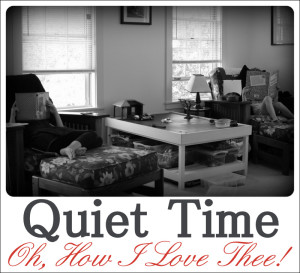
One of the biggest challenges for me when I began homeschooling was the sheer amount of talking and interaction required. Though I was accustomed to having both children home all the time in the summer, teaching them for hours left the introvert in me a bit drained by afternoon. As the rest of the day loomed before me I fondly reminisced about afternoon naps.
There were days when my ears actually hurt and even the sound of them playing in the next room was stressful. {This is when those of you with double or triple the number of kids I have are laughing–I know, I’m a wimp.} I also noticed frequent squabbling during afternoon play because they had been together all day, too!
Enter a homeschool mom’s secret weapon: Quiet Time. The first wise, experienced homeschool mom to reveal this delightful idea to me was Tricia at Hodgepodge. (I always pore over her blog soaking up her wisdom.) I also read a great post from Jamie at The Unlikely Homeschool with her version of quiet time.
I realized this would save my sanity. We tried various arrangements of locations and activities and I nailed down my goals for quiet time (other than just a few blessedly quiet moments to myself). We now have a plan that works for us.
One Hour of Quiet
Quiet time lasts one hour, per Mommy’s timer. Do not ask how many minutes are left. Just remain in your quiet spot until you hear the beep.
The supreme rule of quiet time is that you must be quiet. No talking–especially not to Mommy. I play classical music from our composer of the month during quiet time. The two benefits: my children hear a lot of wonderful music, and it serves as a reminder that this isn’t the time to talk to your family members. (Even if you just saw a picture of a really disgusting bug or wrote the funniest part of your story.)
You must gather what you need before quiet time to prevent getting up during the hour. You may choose the comfortable spot to spend the hour and surround yourself with pleasant, quiet activities.
You must spend some of the time enjoying a good book: my ten-year-old daughter is required to read one chapter, my seven-year-old son must look through one book or listen to an audio book.
We try to fit quiet time in most days, though it often only works on the days we don’t have outside engagements. Sometimes it happens in the early afternoon, sometimes when we return from an errand or meeting, and sometimes I pull it out in that pre-dinnertime hour (especially if Daddy, our chef-in-residence, is home to prepare the meal).
The Quiet Cupboard
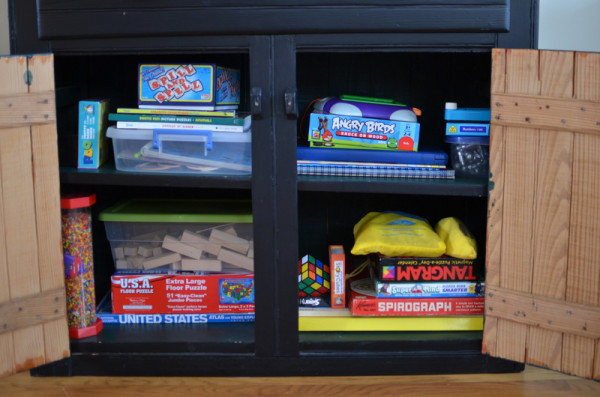
The first day I implemented the “Quiet Cupboard” my kids couldn’t wait for quiet time. The simple idea of arranging an assortment of quiet-time-permissible activities inside a cabinet piqued their interest. The lower shelf has activities good for either child, the top shelf has one side for my daughter and one for my son.
They are welcome to choose things that aren’t in the cupboard but they both gravitate toward the chosen activities. I try to switch it up over each weekend. No massive overhaul needed, just a few changes. They continue to look forward to seeing what’s in the cabinet, and the variety of activities they engage in has increased since the quiet cupboard’s introduction.
What Goes Into the Quiet Cupboard?
Well, the ideas are practically endless, but here’s what you’ll find, on a rotating basis, in our cupboard:
- 1-person games:
- Scrabble Flash
- Spill and Spell
- Chocolate Fix
- PDQ: The Pretty Darn Quick Word Game
- Bananagrams (the tiles can be fun to play with, my daughter makes intersecting words on a theme for fun)
- Rory’s Story Cubes
- Tangrams (we use an old page-a-day magnetic calendar)
- Supermind
- Find It
- Puzzles (I especially love to slip geography puzzles in here)
- Blocks: our Legos are out constantly, but I’ll put other smaller block sets in here like Lincoln Logs or Tinkertoys
- Clipboard with paper and pencils–these can be used with some of the activity books or by themselves for drawing or writing
- Activity books:
- How to Draw (fill in the blank) books: we have ones for animals, people, and even military vehicles!
- Mazes
- Crossword puzzles
- Doodling books: Doodles at Dinner is one of my daughter’s favorites
- Visual search books like Hidden Pictures, Where’s Waldo, or Photo Fun
- Soduku
- Art and craft supplies that don’t make big messes (not the time for ink pads, paints or chalk pastels)
- Stencils
- Klutz books are always a hit: quilling, friendship bracelets, paper airplanes, cat’s cradle, Spirograph
- Do-a-Dot markers
- Card kit: I put together a box with blank cards, fancy edge scissors, and cardstock scraps
- Books: though they can choose a book from anywhere, if I want to draw particular attention to a book I’ll put it in here. Books from the library or home, maybe one with beautiful artwork or photography, maybe one that goes with our season or studies (nature, science, history, art–so many choices!)
After Quiet Time
I can be a little tempted to keep my nose in a book or working on whatever focused task I was doing. But (most days) I resist the urge and jump back into family life. I take the time to admire creations, listen to story lines, or examine interesting finds from our hour “apart.” We all enter our evening refreshed and ready to enjoy each other.
Do you practice quiet time in your home? Share your version in the comments!
*This post contains affiliate links.
Schedule Changes Make Room For Our Priorities
I’ve struggled with feeling over-scheduled since the beginning of the school year. We rarely had a whole day at home, and it was a nagging bother because the days spent at home seemed closer to my core homeschool priorities. We could always get the basics done (the three Rs) but only on slower weeks could we get to the “extras” that matter to me: nature study, hands-on activities, artist and composer studies, time for personal interests.
I made small changes and waited it out, figuring after the holidays during the bleak winter months we’d be glad for the busyness. February arrived and I wasn’t glad, just busy.
I mulled it over, talked with my family, and decided to take out two activities. Each occurred only once a month but required planning from me and school time during that week for the kids to prepare. The problem? The two activities were good activities with nice people, and they depended on the participation of the involved families to keep going.
I notified the groups, and some members were disappointed. I felt sorry and yet that I had done the right thing for our family. This week reinforced my choice.
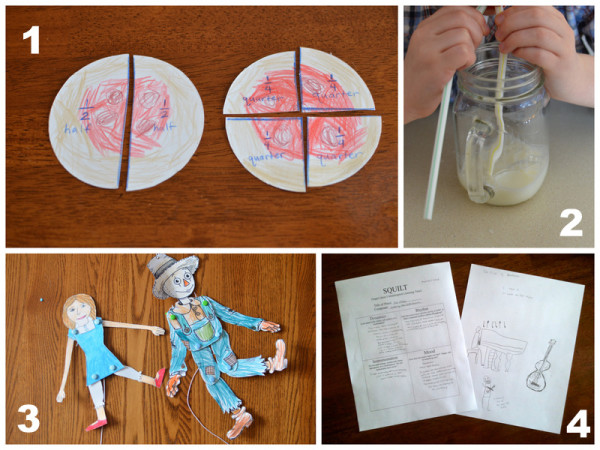
- My little boy loves and needs hands-on learning: here are our homemade (pepperoni) pizza fractions.
- More hands-on learning fun: after watching Beakman (our favorite science show–all episodes streaming on Netflix!) we had to try the Beakman Challenge: sucking from a straw with a second straw out of the fluid. P.S. It’s impossible and it all has to do with air pressure.
- We delved into our history program every day this week. These are our Jumping Jacks, a popular toy from the 1800s. My son colored the printable one, my daughter designed her own.
- One of our “extras” is composer study. We’re working on Beethoven and enjoyed another SQUILT lesson for Fur Elise. Thanks ever so much to Mary from Homegrown Learners for teaching us all about Super Quiet Uninterrupted Listen Time!
My children enjoyed their non-school hours, too.
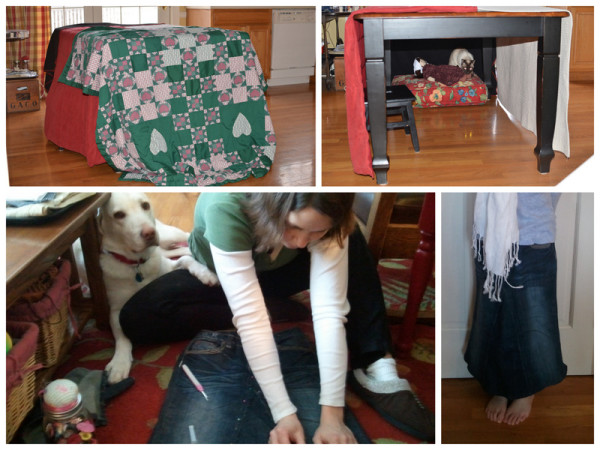
- Imaginative play: The kids built a covered wagon in the playroom, then a claim shanty out of the kitchen table. It even had a quilt for a door like Ma Ingalls.
- Time for personal interests: My daughter completed a sewing project from her book Kids Can Do It: Simply Sewing. She took a photo of lovely me (in my pajama pants) helping with pinning to capture our very helpful sewing assistant, Martha Dog. The completed transformation of jeans-into-skirt was a success and my daughter has basked in many compliments. I love the lessons learned and pride that comes from sewing for her.
- What else? My son practiced until he could do a double-somersault, my daughter did math in her spare time (Life of Fred Fractions–I may be in love but don’t want to judge too quickly), we sorted and delivered Girl Scout cookies, and enjoyed lots of reading aloud, including all of The Twits just for fun. Roald Dahl gives my son belly laughs and I love to share that with him.
Now, this doesn’t mean we’ve become hermits. With church, Scouts, two book clubs and music lessons we’re still on the road many days. But we’ll have a couple more days at home and more freedom to work on our priorities. And a bonus: it cleared up some mental space for me since I had to plan what we would prepare for both events. I need all the mental space I can get!
How is your schedule working this year? Do you have a hard time balancing time at home and outside activities?
Thank you to the wonderful hostesses with fun link-ups on Fridays. Be sure to join the fun and see what other homeschoolers are up to!
A Beautiful Moment
We were in the basement of our small town library for the once a week book sale. My ten year old daughter and her dad were perusing a small wooden bookshelf with old books.
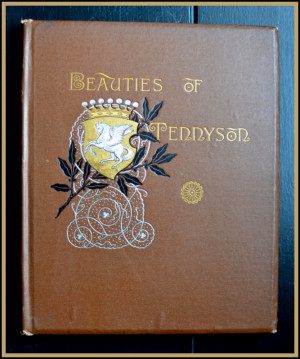
She brought one over to show me because of the beautiful cover. As we read the title, Beauties of Tennyson, both our eyes widened.
Backtracking a bit: we recently finished the Little House series. Those stories have become part of the fabric of our family and we were sad to be done living Laura’s life through her books.
It was a perfectly new book, beautifully bound in green cloth with a gilded pattern pressed into it. The smooth, straight, gilt edges of the pages looked like solid gold. On the cover two curving scrolls of lovely, fancy letters made the words: Tennyson’s Poems.
~From Little Town on the Prairie by Laura Ingalls Wilder
We carefully opened the cover to check the date: 1885…Laura’s time period! My daughter opened it and found “Song From Maud.”
Laura tried to read again her favorite of Tennyson’s poems:
Come into the garden, Maud,
For the black bat, night, has flown,
Come into the garden, Maud,
I am here at the gate alone;
And the woodbine spices are wafted abroad
And the musk of the rose is blown.
~From Little Town on the Prairie by Laura Ingalls Wilder
My daughter’s face flushed as she gingerly held the book in her hands. “You have to get that book,” I said. She left the proud owner of Beauties of Tennyson.
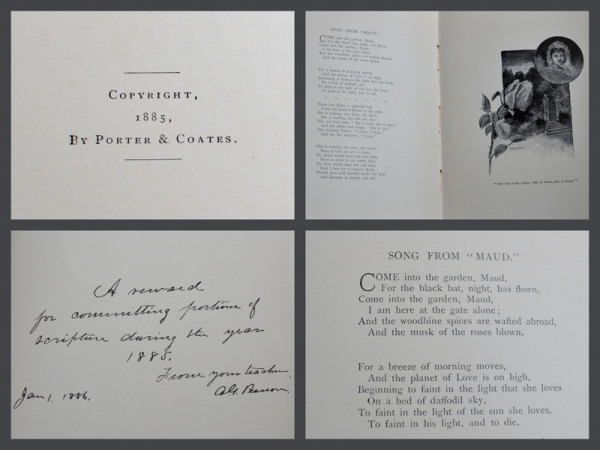
Isn’t it beautiful? Look at the dedication:
A reward for commiting portions of scripture during the year 1885.
From your teacher,
[teacher’s name]
Jan 1, 1886.
What else did we do this week? A lot. Outside engagements every day. Too many errands. Reading, writing and arithmetic. There are times I feel I’m not managing it all very well. We rarely get all the schoolwork I planned crossed off my list. The house gets far too messy. I’m often trying to figure out what’s for dinner at 4 pm. I snap at the people I love most.
But this moment in the basement of the library was perfect.
My growing-up-way-too-fast little girl had tears in her eyes over a 128 year old book of poetry. I must be doing something right. Sharing quality literature, poetry, and music is having an impact on their lives, now and hopefully forever.
I’m going to store this memory, dwell on it, and let it overshadow other less-than-perfect moments.
I’m linking up–click over and see what other homeschoolers are doing.
Poet Study: Robert Frost

I read poetry to my children regularly. Sometimes I share poems from anthologies and sometimes poems related to the season, holiday, or our studies in nature or history. Other times we focus on one poet, and March is a great month to enjoy a study of Robert Frost, who was born on March 26th, 1874.
Other than the fact that it’s his birthday, and that he’s one of America’s best-loved poets, what homeschooler doesn’t identify with these famous lines:
Two roads diverged in a wood, and I–
I took the one less traveled by,
And that has made all the difference.
~from “The Road Not Taken” by Robert Frost
Getting to Know Robert Frost
Born and raised in Maine, I feel a special connection to his poems depicting scenes of rural New England life. I was amused to find that he was actually born in California! He moved to New England (where his family was from) when he was 11.
Although he was writing poems as a young adult he was not able to support himself as a poet until much later in his life. In the meantime he wrote for newspapers, taught, and farmed (though not very successfully). It wasn’t until he moved to England in his late 30s that his work was accepted by a publisher in Britain. He moved back to America, and ten years after his first book of poetry was published he won the first of four Pulitzer prizes.
Poetry for Young People: Robert Frost has a short biography of the poet. This biography online also has nice information about not just his poetry but also his personal life. I find his life story interesting and worth sharing with my children: there is a lesson to be learned about following your passion even if you aren’t immediately successful.
Getting To Know Robert Frost’s Poems
I can’t recommend the Poetry for Young People series highly enough. With the story of the poet at the beginning, and then a selection of poems with accompanying artwork, it is worth adding to your bookshelf. I also appreciate the notes at the bottom of the page that help explain the theme or style of the poem.
Several of his poems have been made into picture books–a perfect way to introduce his poetry to younger children and enjoyed by all ages in our home:
Here are some free resources for enjoying his poetry:
- There are links to many of his poems on the right sidebar at The Academy of American Poets website.
- Librivox has a free audio download of eight poems.
- You can also watch a video of Frost reading “Stopping By Woods on a Snowy Evening.”
Adding the Extras
Reading about the poet and sharing his poems can stand alone, but you can further the learning (or just the fun) by adding in any of these enrichment ideas.
- Jimmie has perfect Robert Frost Notebooking Pages over at the Notebooking Fairy.
- Use one of his poems for copywork.
- Have your child memorize their favorite Frost poem.
- Print a poem and have your child illustrate it.
- The chalk pastel tutorials Tricia posts at Hodgepodge are one of my favorite art resources! Several would go well with the scenes of nature in many Robert Frost poems: To The Woods, Tree Silhouette, Apple, Old Shed in the Snow.
- According to the Robert Frost Farm website, the Frost family served banana pudding topped with chocolate syrup and whipped cream at birthday parties. I’m always game to add food to our studies!
Hop on over and check out other unit studies of fascinating people born in March from the bloggers of iHomeschool Network!
Nature Study ~ Birds

Our nature study has been all about birds for the last 6 weeks. It’s a good winter topic for Maine–they are one of the few living things outside that aren’t covered in snow! We focused on the basic features of all birds and the specific birds that we see outside our window.
Resources For Studying Birds
- Handbook of Nature Study bird posts ~ Barb guides you through nature study, and this is the reference page that links to all her bird-related posts
- Handbook of Nature Study by Anna Botsford Comstock ~ the big black reference book for nature study, I highly recommend having this one on your bookshelf. I use it mostly to educate myself so I can guide our observations in nature, though I sometime read short sections to the kids.
- Birds of Maine Field Guide ~ I highly recommend the state guides by Stan Tekiela. We love this book and it has made it much easier to identify new-to-us birds. The entries are organized by color, so if you see a bird that is primarily brown or blue you can look in that section and find just birds of that color likely to be in your state.
- Burgess Bird Book for Children (available as a free Kindle book) by Thornton W. Burgess ~ I enjoy the Burgess books for children–sweet stories with factual information.
- Everything You Never Learned About Birds by Rebecca Rupp ~ a wonderful book filled with scientific details, hands-on learning activities and amusing tidbits and stories. One of those really fun nonfiction books that works well even as a read aloud.
- All About Birds ~ The amazing online bird guide from the Cornell Lab of Ornithology.
- Nestcams ~ We kept an eye on two nestcams from Ustream: a hummingbird and eagle nest, both with two nestlings. They provided us with a great opportunity to observe things that would be impossible to see first-hand in nature.
The Egg
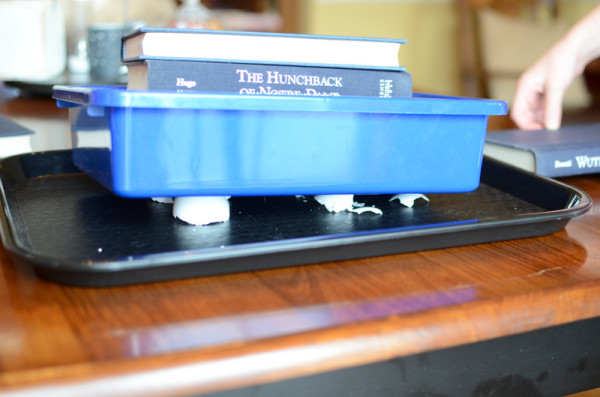
After reading about the egg in Everything You Never Learned About Birds we tried this experiment to see exactly how much weight eggs could hold. I cracked two eggs as close to the middle as I could. (I tapped with the dull edge of a knife to try and break it evenly all the way around.) We placed the empty shells down and tested to see how much weight they could hold.
Even I was amazed when they broke at just over four pounds–roughly the weight of a hen! It seems they were perfectly suited to withstand their mother’s weight. We were able to tie the idea of the strength of the dome shape into our recent visit to our state capitol building.
Bird Bones
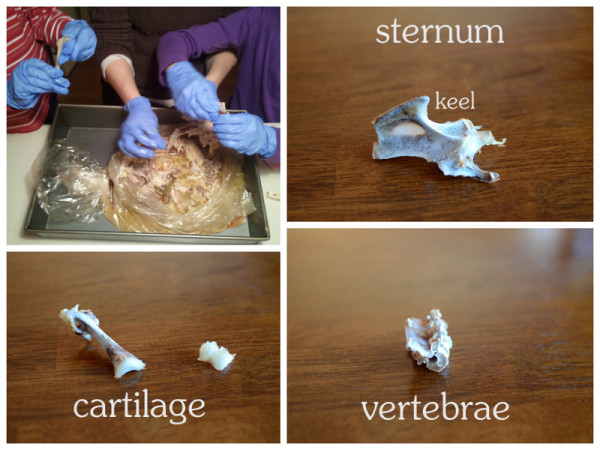
Who but a homeschooling family would have a baked chicken for dinner just so they could examine the skeleton after? I was glad we went through the effort, because even though my daughter was initially horrified at the idea she, too, was interested in all we saw. We were able to spot many things we have in common with birds: vertebrae (and even the spinal cord!) and cartilage. I was hoping to show a cross-section of a bird bone and show how they are lighter and more hollow than mammal bones–but that just wasn’t easy for us to see. The most amazing feature specific to birds was the large “keel” where the chest muscles attach to the sternum. Comparing it to our breastbone (on our skeleton model) the difference was incredible.
Feathers and Flight
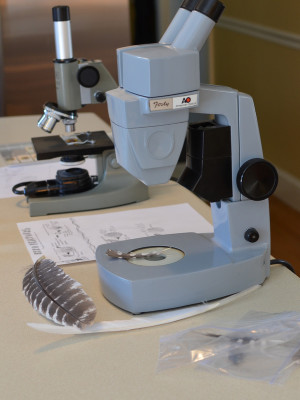
We examined the details of a feather under the microscope. This is the part I love about nature study: the more you learn the more amazed you are with the intricacy of nature! All of us were intrigued examining the microscopic features of a feather, especially the little hooks that keep the parts of a feather together forming a neat fan. (We decided it was kind of like Velcro!)
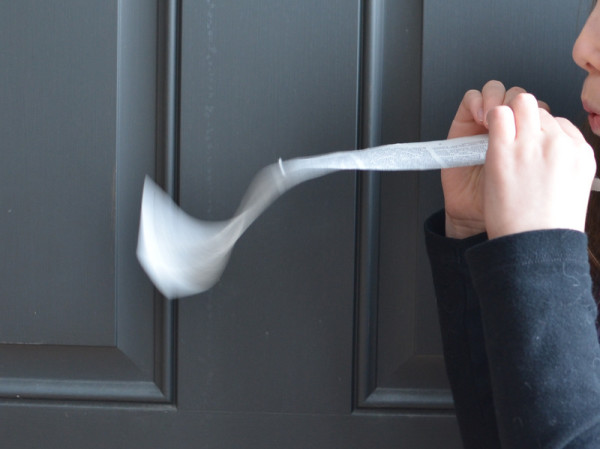
We’ve read about both bird and plane flight before as it has come up in questions from my son. This easy demonstration was one that even I was surprised worked so well and had us all ooh-ing and ahh-ing…and blowing on newspaper until we were dizzy! Simply hold a 3-inch by 12-inch strip of newspaper just under your mouth and blow. It may take a minute to get it just right, but when you do the newspaper will flap upwards. It’s a great hands-on demonstration of lift, more officially known as Bernoulli’s Principle!
Getting to Know Our Backyard Birds
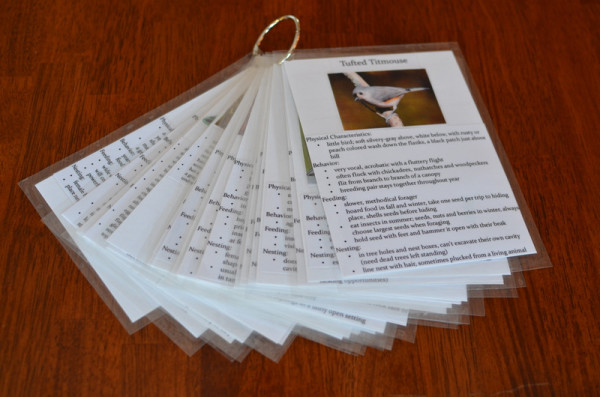
We focused the rest of our time on learning even more about our backyard bird friends. We started our own field guide (Outdoor Hour Challenge #7) last year, and added new birds this year. While I enjoy our growing collection of field guides, I love having our own guide to just our backyard birds. On each card I put a picture and pertinent information, and also add interesting tidbits on the back.
We spent extra time on a few of our frequent backyard birds.
- Barb has a great post about the crow with a video. We can get frustrated with the crows who take all our suet and scare away smaller birds, but after Barb’s post and the accompanying pages in the Handbook of Nature Study (p. 124-127) we had to appreciate their intelligence.
- We have Chickadees, Nuthatches and Downy and Hairy Woodpeckers in our yard. Using information from the Handbook of Nature Study I shared with my children about how these birds comb over different parts of the tree looking for insects and their eggs. The interplay of these species again prompts us to marvel at creation.
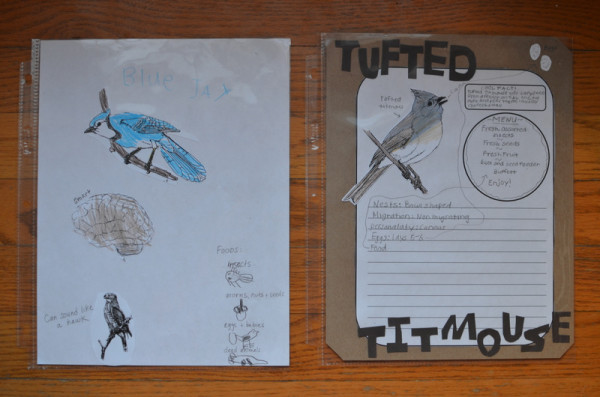
- I had my children choose their favorite bird and create a notebook page. We used the coloring images from the free Cornell bird coloring book, and then I set them free to record the facts they found interesting.
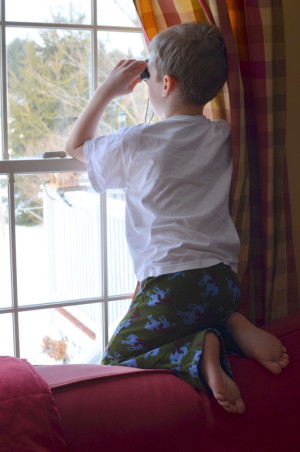
- The highlight of our bird study was our second year participating in the Great Backyard Bird Count. Read over Barb’s post about the GBBC and you’ll be persuaded to become a citizen scientist, too! Here are our 2013 bird counts, with the highest number seen of each species at one time:
- White Breasted Nuthatch: 2
- Red Breasted Nuthatch: 2
- Black-Capped Chickadee: 6
- Dark-Eyed Junco: 3
- Crow: 3
- Blue Jay: 3
- American Goldfinch: 14
- European Starling: 2
- House Finch: 1
- American Tree Sparrow: 2
- Common Redpoll: 1
- Cardinal: 2
- Mourning Dove: 1
I love that even in a small in-town yard we can enjoy these marvels of nature right outside our window. And as with all nature topics, I often feel like we’re just scratching the surface of what we want to learn! Our next goal is to learn the songs of our backyard birds.
I’ll end with this video that blew our minds of starling murmuration. Unbelievable!
I’m participating in Barb’s Outdoor Hour Challenge carnival, head over to her blog for encouragement in your nature study.




